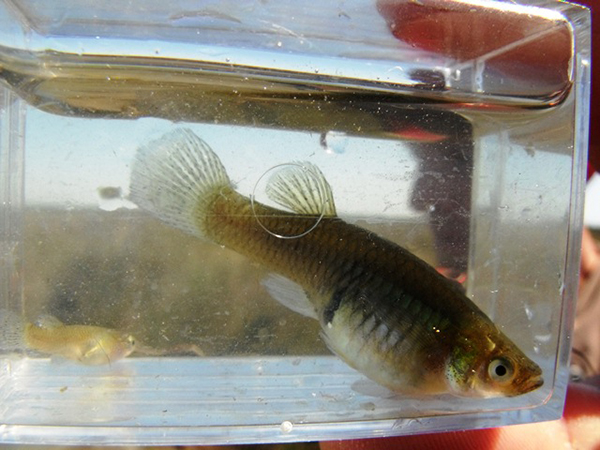‘Trojan Y’ the downfall of pest fish
By John Duggin, Tamar Island Wetlands Centre Volunteers Group

Gambusia holbrooki female and male. Photo: Massimiliano Marcelli
Each year the group of 26 volunteers provide more than 5500 unpaid hours to the TIWC and the local community, acting as the first point of contact in interpreting the Tamar Island Wetlands.
A large part of our work involves partnering with the University of Tasmania’s (UTas) ‘Trojan Y’ research project to eradicate gambusia from within the wetlands.
Gambusia was introduced to Australia in 1925 as part of an international malaria control program.
The fish was believed to decrease the population of mosquitoes that carried the disease by eating the mosquito larvae and pupae.
Gambusia was first reported in Tasmania in 1993 when it was released into a farm dam in close proximity to the Tamar River in northern Tasmania.
It was later found in the Tamar Island Wetlands in 2000.
With the ability to establish quickly in freshwater ecosystems, gambusia is an enormous threat: competing for food with native species such as the vulnerable green and gold frog.
It also attacks other fish and tadpoles, reducing their survival rates.
Concerned with the impact of this pest fish, the TIWC Volunteers Group were involved in implementing control programs, experimenting with different netting and trapping techniques, and modifying habitats to make channels less favourable to gambusia.
We also undertook routine sweep-netting sampling for population assessments and dip-netting for eradication.
Unfortunately, these standard techniques for population control were limited in their success.
‘Trojan Y’ was established by UTas in collaboration with Inland Fisheries Service Tasmania, NRM North, and TIWC Volunteers Group.
The aim of ‘Trojan Y’ is to manipulate sex ratios so that successive generations of the fish become almost entirely female, reducing reproduction and continuity of the population.
Using hormones, the sex of these species are able to be reversed – male to females and females to males – without involving genetic modification, mass killing or causing ecological harm.
TIWC Volunteers Group assist this project by undertaking weekly population monitoring, maintaining fish stock, and educating the community on the impacts of introducing unwanted species.
So far current results are demonstrating great promise.
However, ‘Trojan Y’ requires further controlled laboratory studies, tank tests, and environmental assessment that are beyond the current project, but we continue to explore other options and hope that one day gambusia will be a thing of the past.



